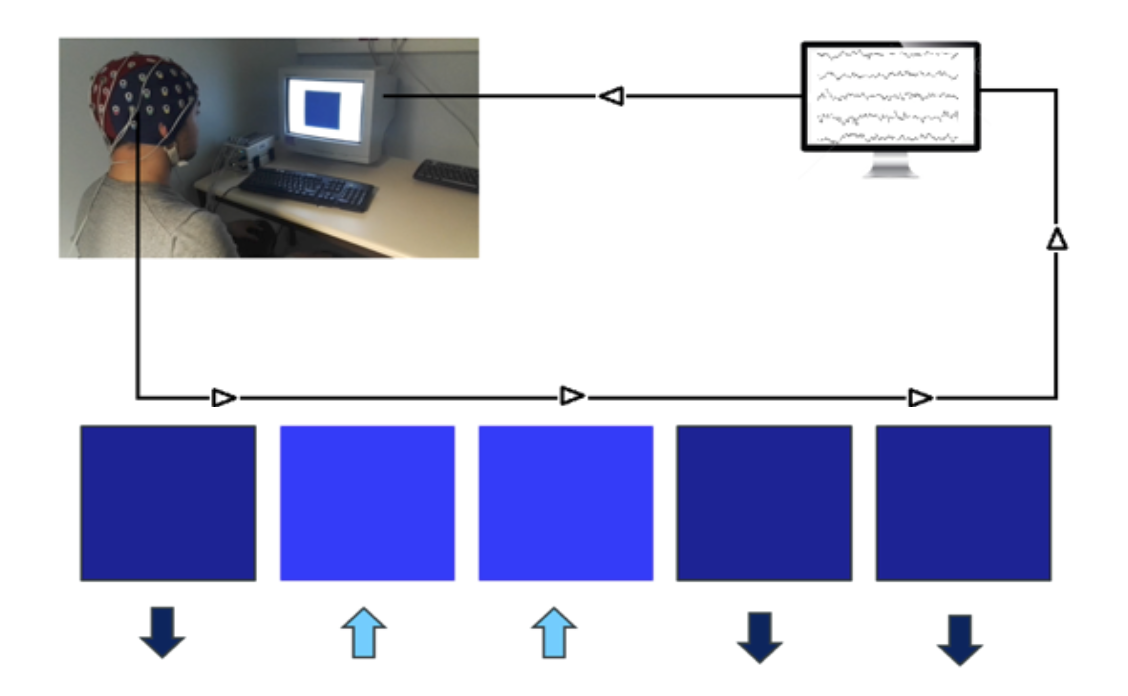Neural correlation of meditation
As a meditator, I have always been fascinated with human consciousness, and how to try to understanding both inwardly (though meditation) and outwardly (using the scientific method). I oriented my career to attempt to understand consciousness during meditation and obtained a Varela award from the Mind and Life fundation in 2004 (the first year it was instated). With my colleague Rael Cahn, we first observed that meditators in the Vipassana tradition tend to exhibit higher gamma activity as shown below for scalp electrode Oz [1].

Not all meditation practices are the same, and this is a huge issue in meditation research. People will refer to meditation, but it could be mantra based, body scan, or visual concentration. We therefore tried to study how brain activity was modulated by different meditation practices. We found that again most meditator tend to exhibit more gamma activity compared to control subject, irrespective of the meditation practice (again electrode Oz below) [2].

Meditation and mind-wandering
But what kind of mental state can meditation be compare to? What meditation practice brings to awareness is that private thoughts and feelings constantly pull the attention away from one's person focus. This experience is not restricted to meditation practice. In our normal daily activities, we may notice that instead of being focused on the task at hand, we are focusing on unrelated thoughts and feelings. A common example is, when reading, the sudden awareness of not being reading anymore even with our eyes still going on dwelling on the page. These attention drifts are termed mind-wandering. This is called in the Buddhist philosophy "monkey mind". We review this in a chapter on meditation and neurosciences [3].
Mind-wandering is an unconscious process. It generally occurs without the subject being aware of it, it is only after a certain time that one becomes aware of his attention being decoupled from his task. My research shows the EEG correlates of mind wandering in different conditions linked to meditation practice. It also shows for the first time that attention decreases mind wandering. It finally suggests neurofeedback could be used as attention training to modulate mind-wandering or change its content.
In one experiment, we ask 16 people to count their breath (a basic meditation practice) and to press a button whenever they were aware that they lost the count. We considered mind-wandering as the 10-second period preceding the button press and concentration/meditation as the 10-second period following the button press. We observed interesting changes in the theta and other frequency bands as shown in the spectrogram below for electrode Oz [4].



Meditation, mind-wandering, and neurofeedback
As soon as 2010, Romain Grandchamp, who did his PhD under my supervision, had the idea of using a dome to visualize brain activity. We made this part of his thesis and published our results showing greater immersion and educational potential of this neurofeedback platform [7].
The future of meditation research
Finally, one of my important effort has been to try to promote the study of spirituality using modern scientific methods. I have been organizing or co-organizing a series of 4 meet-up where scientist discuss the future of meditation research. My views are expresses in the short video below.
[1] Cahn, R., Delorme, A., Polich, J. (2012) Event-related delta, theta, alpha and gamma correlates to auditory oddball processing during Vipassana meditation, Social Cognitive and Affective Neuroscience, 8(1):100-11. PDF, Pubmed link.
[2] Braboszcz C, Cahn R, Levy, Y, Fernandez M, Delorme A (2017) Increased gamma brainwave amplitude compared to control in three different meditation traditions. PLOS One. In press.
[3] Braboszcz, C., Hahusseau, S., Delorme, A. (2010) Meditation and Neuroscience: from basic research to clinical practice. In "Integrative Clinical Psychology, Psychiatry and Behavioral Medicine: Perspectives, Practices and Research". Editor: R. Carlstedt. pp 755-778. Springer Publishing. Author's PDF, Amazon link.
[4] Braboszcz, C. and Delorme, A. (2011) Lost in thoughts: neural markers of low alertness during mind wandering. Neuroimage, 54(4):3040-7. PDF, Pubmed abstract.
[5] Durantin, G., Dehais, F., Delorme, A. (2015) Characterization of mind wandering using fNIRS, doi: 10.3389/fnsys.2015.00045. Full text available on Frontiers web site.
[6] Brandmeyer T., Delorme A. (2016) Reduced mind wandering in experienced meditators and associated EEG correlates. Exp Brain Res. Nov 4. Pubmed abstract, author's copy of published manuscript.
[7] Grandchamp, R., Delorme, A. (2016) The Brainarium: An Interactive Immersive Tool for Brain Education, Art, and Neurotherapy, Journal of Computational Inteligence, dx.doi.org/10.1155/2016/4204385. Full text available on publisher web site.
[8] Brandmeyer, T., Delorme, A. (2013) Meditation and Neurofeedback, Frontiers in Psychology, doi: 10.3389/fpsyg.2013.00688. Full text available on Frontiers web site.



